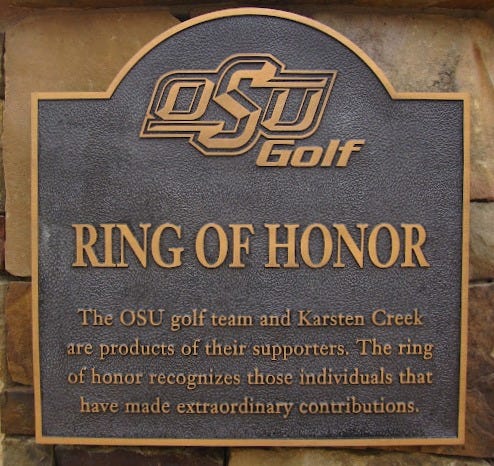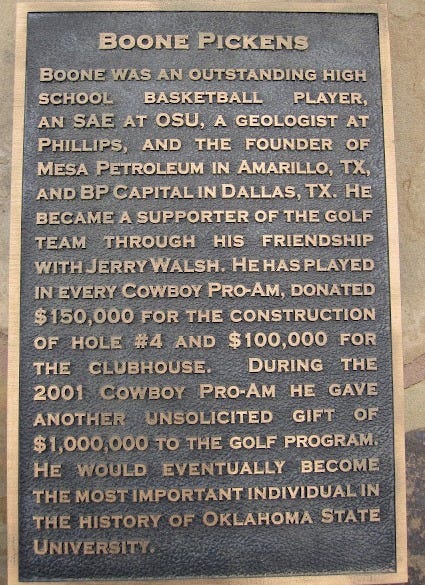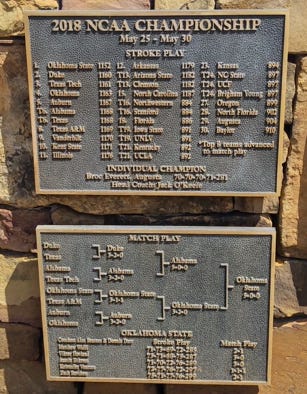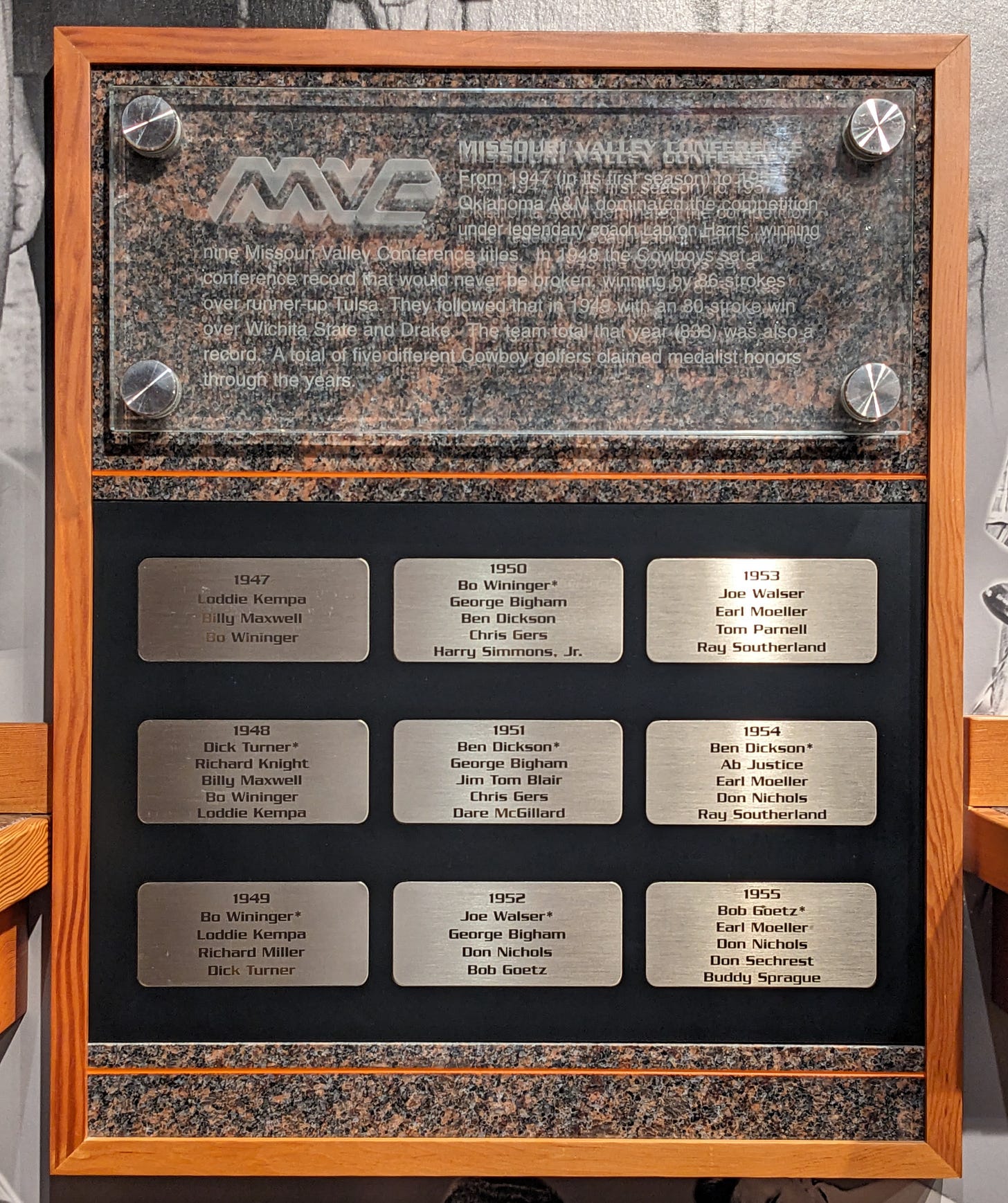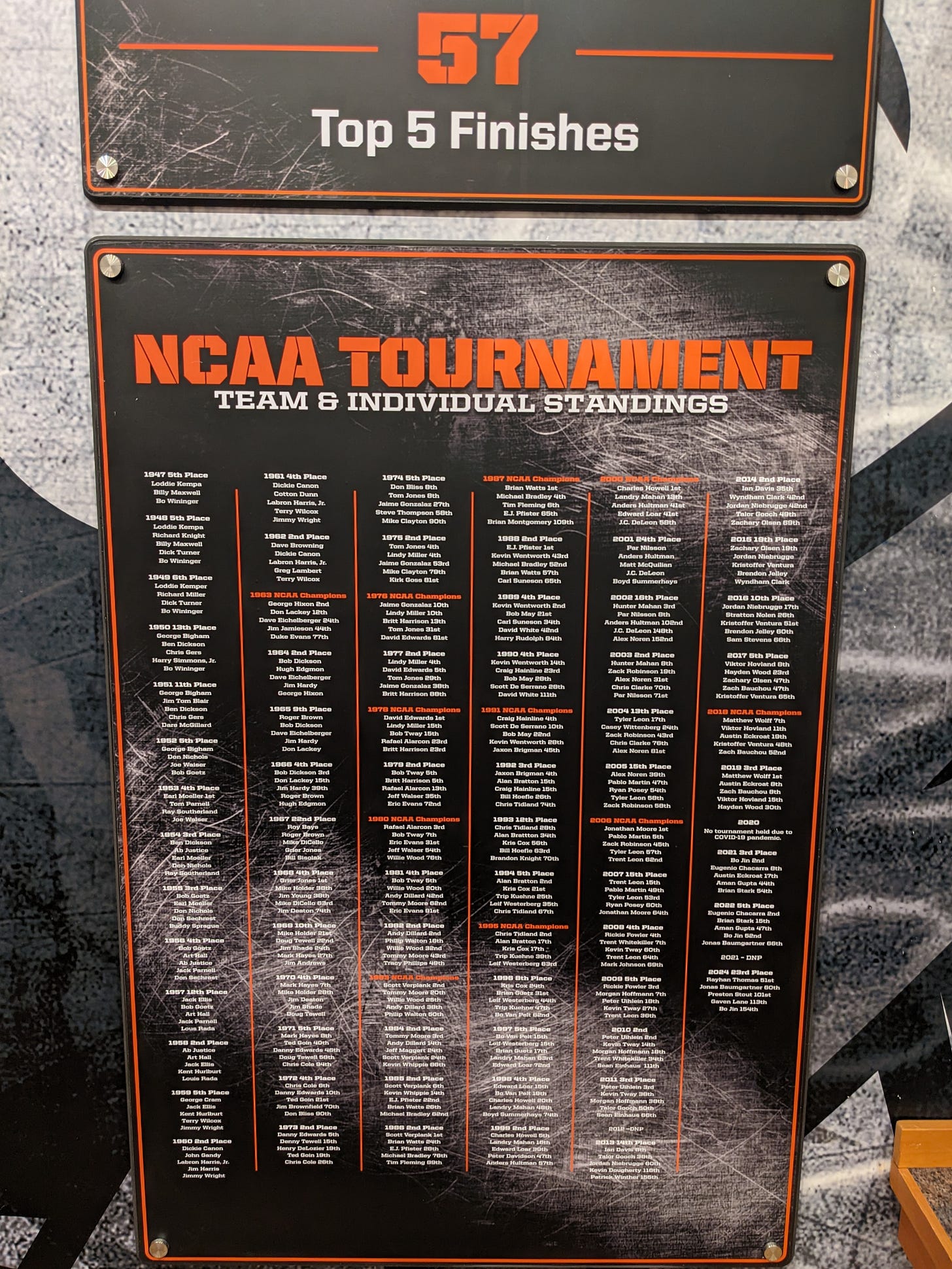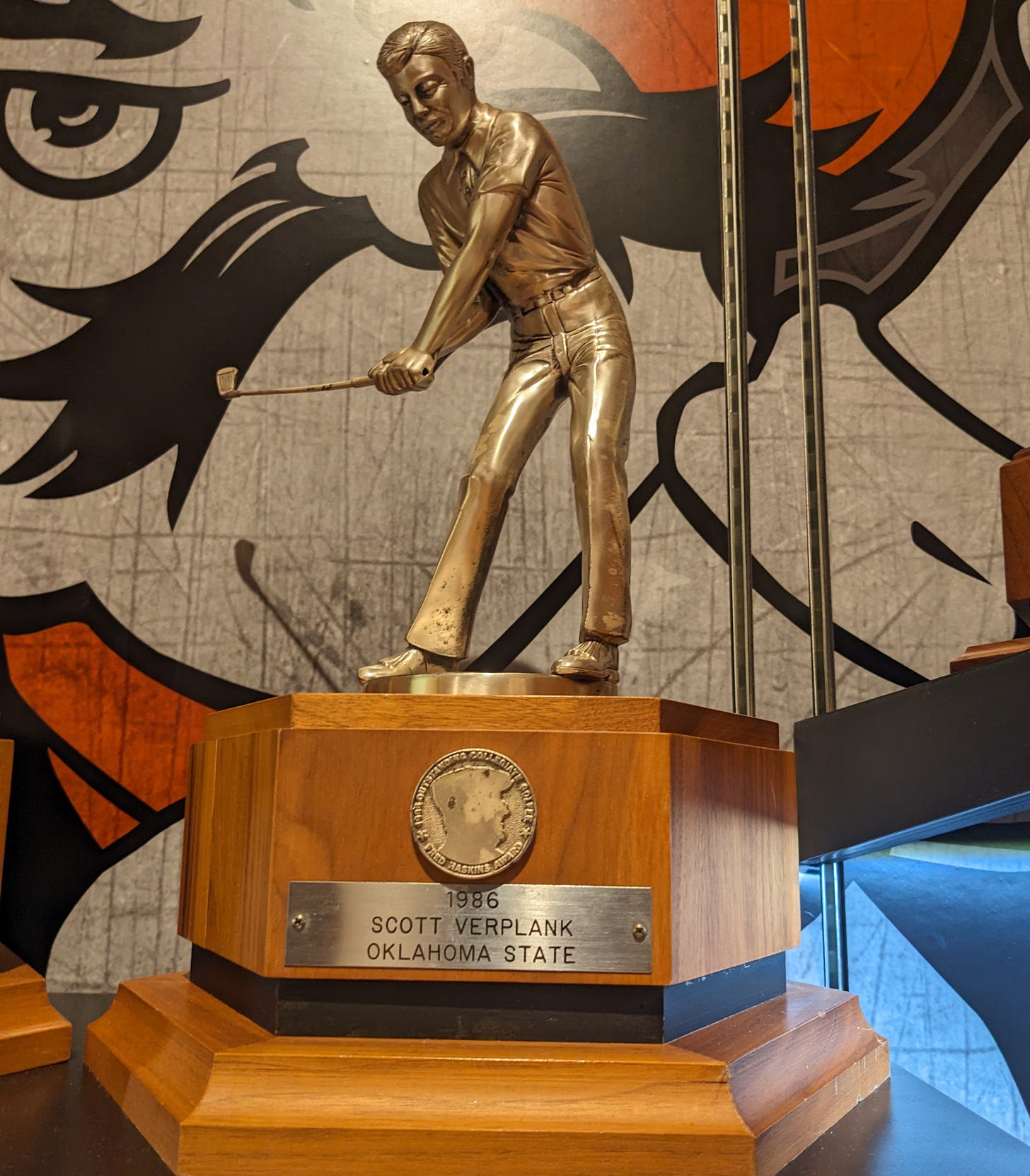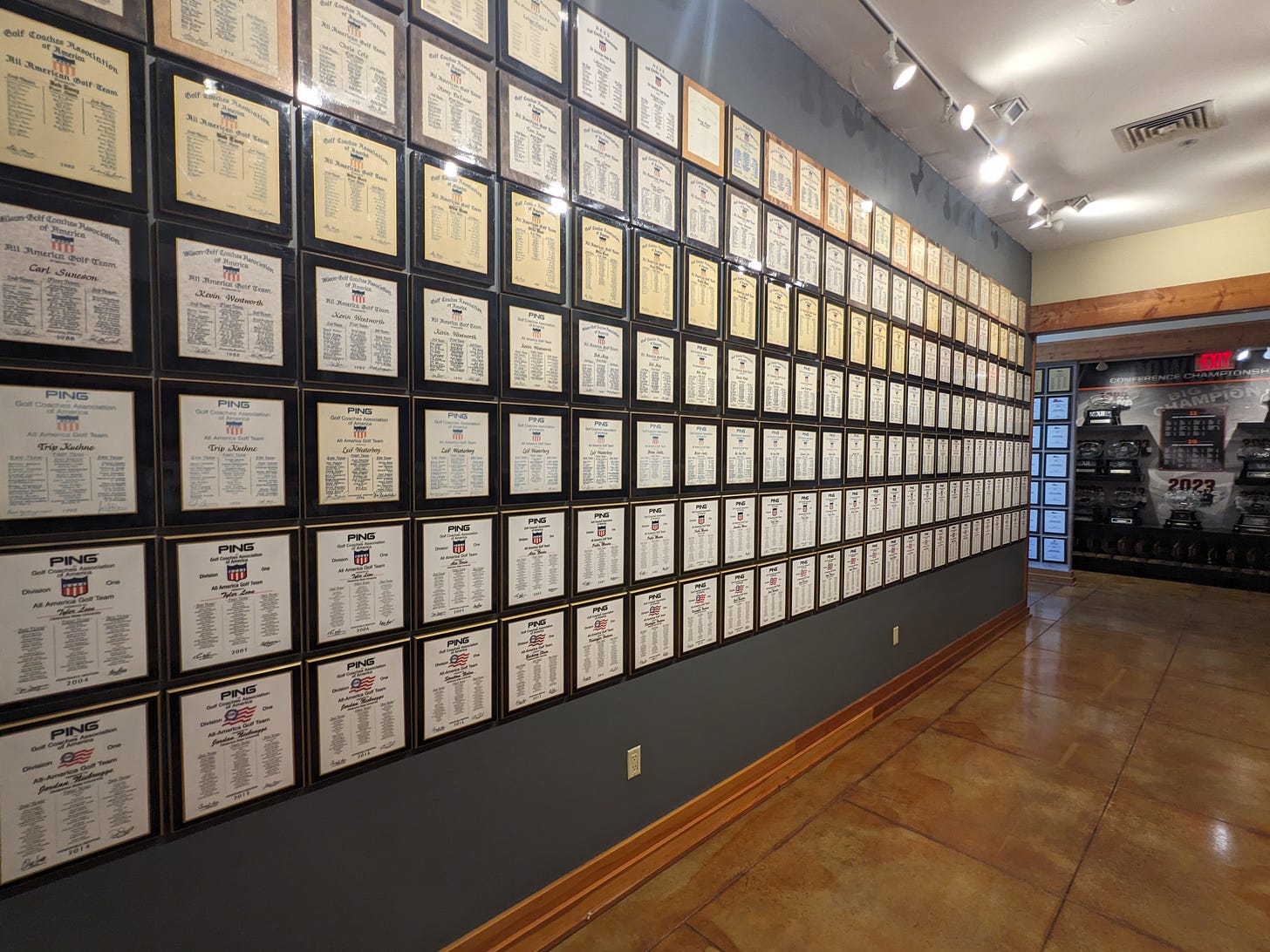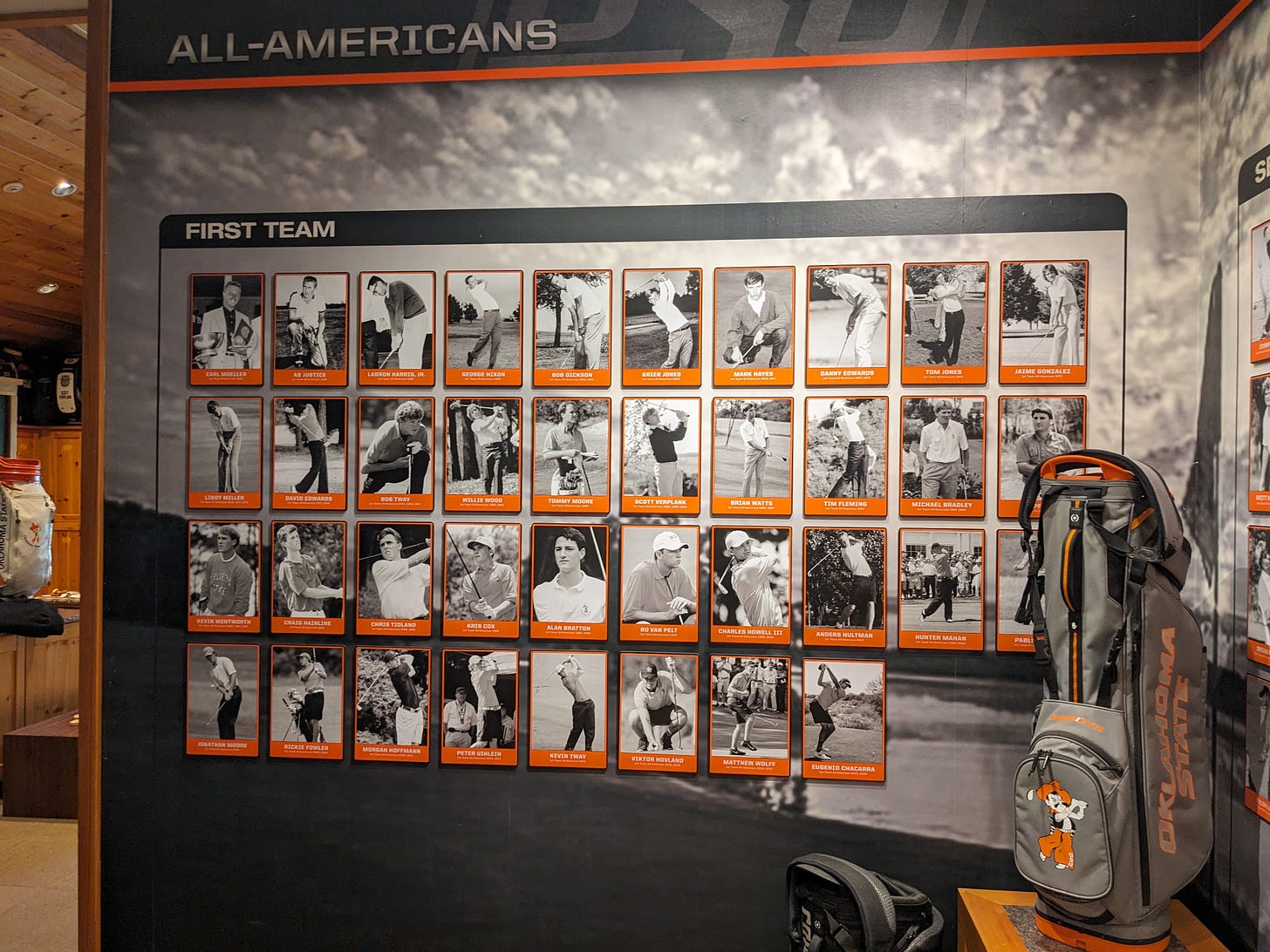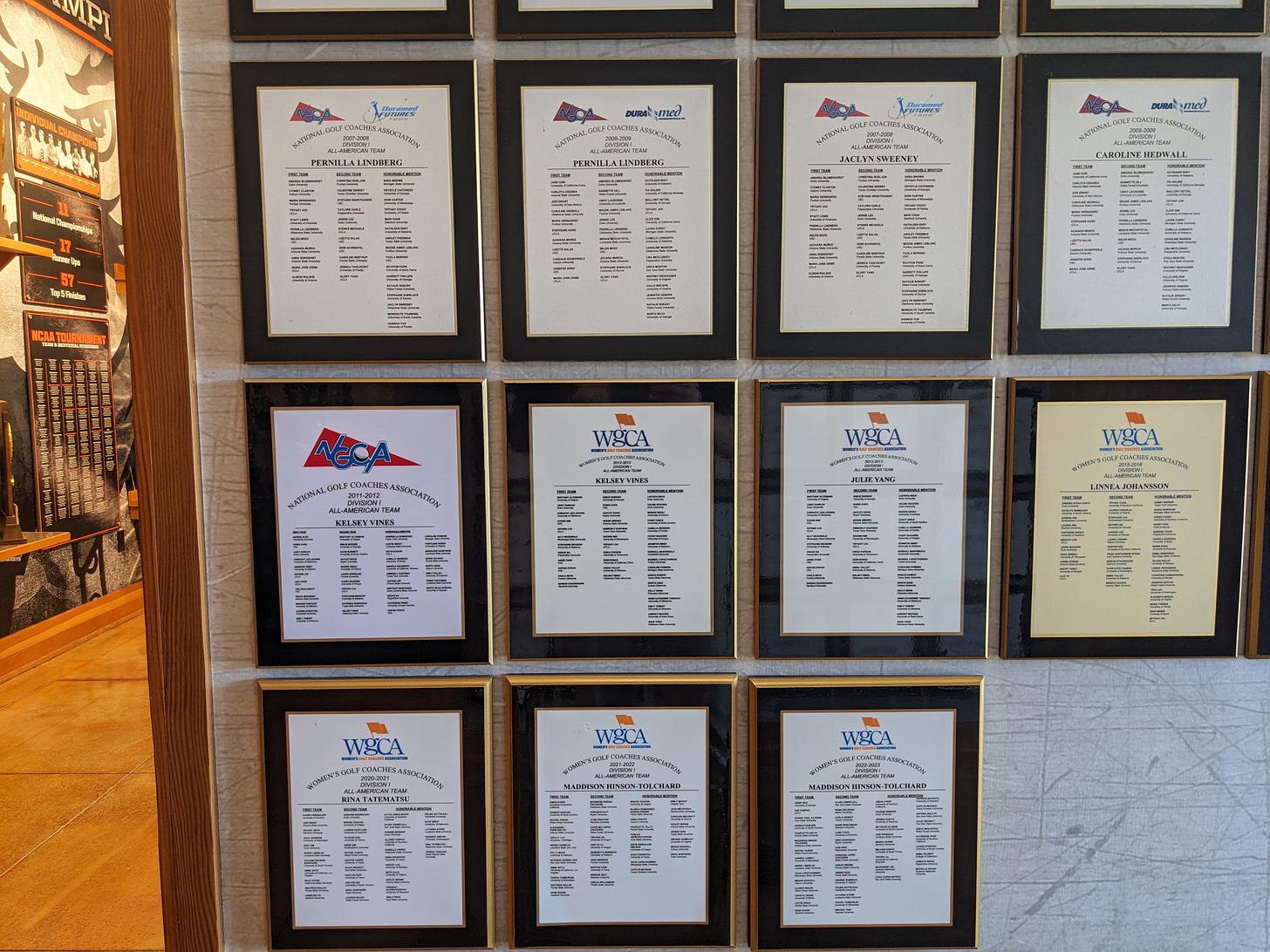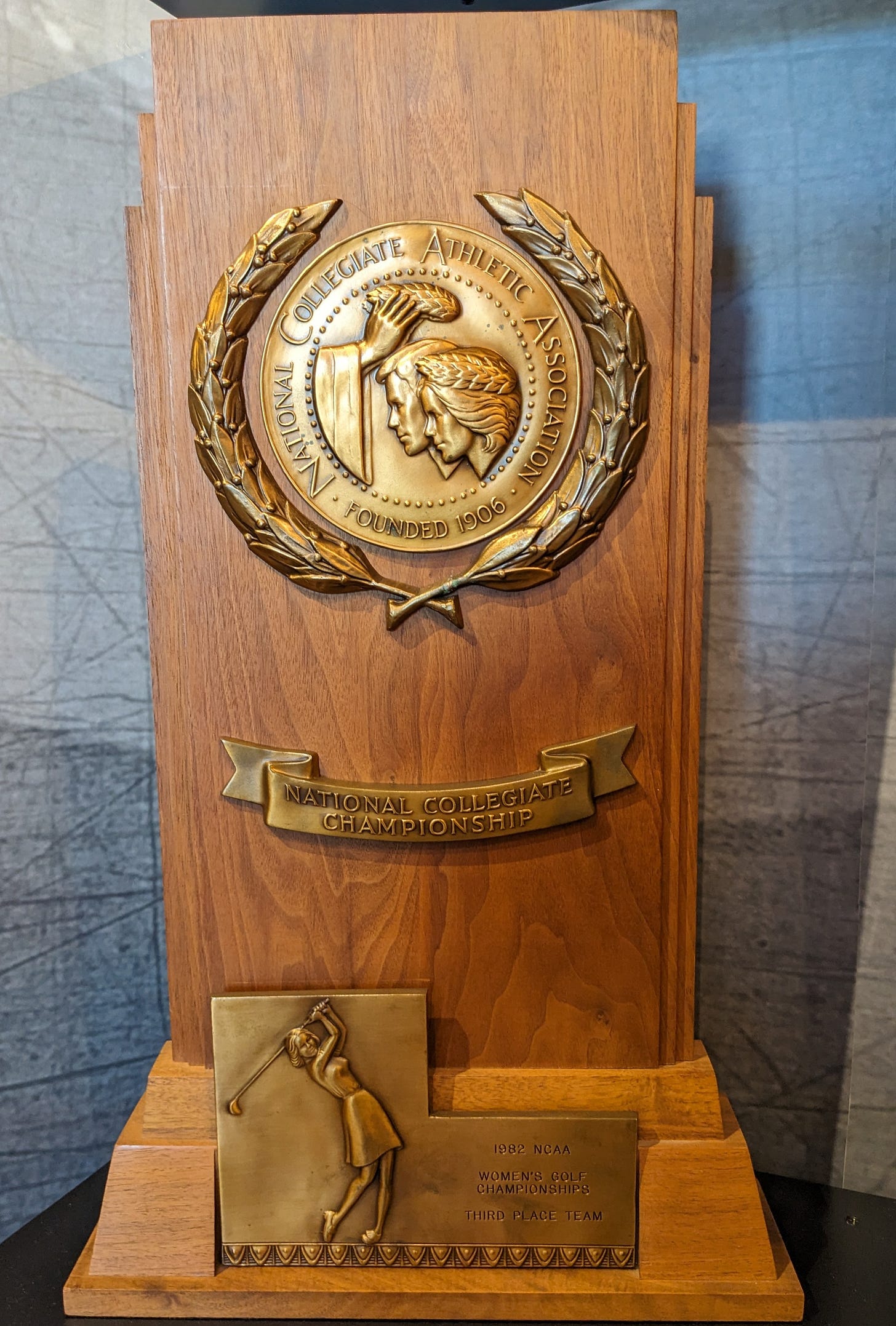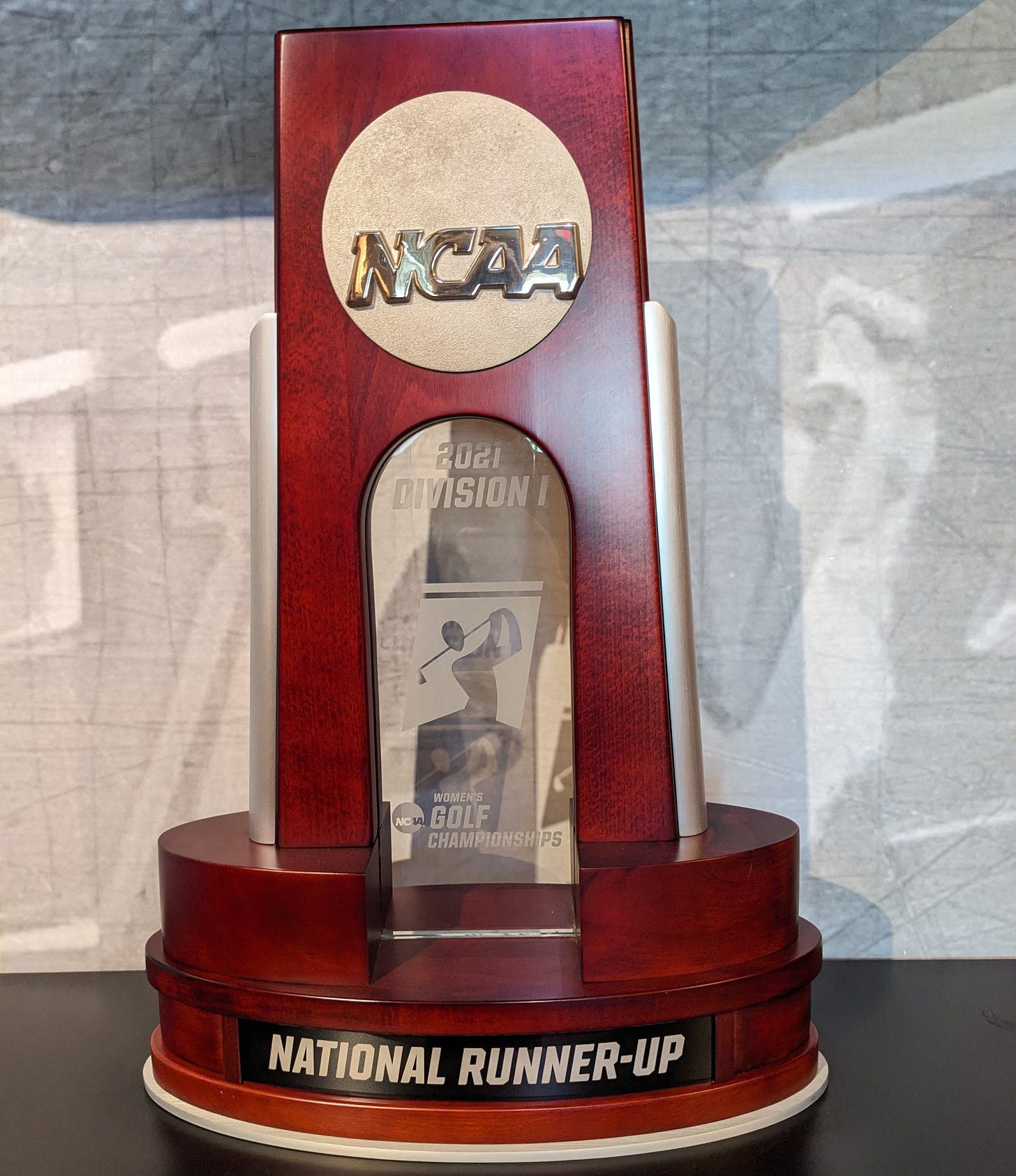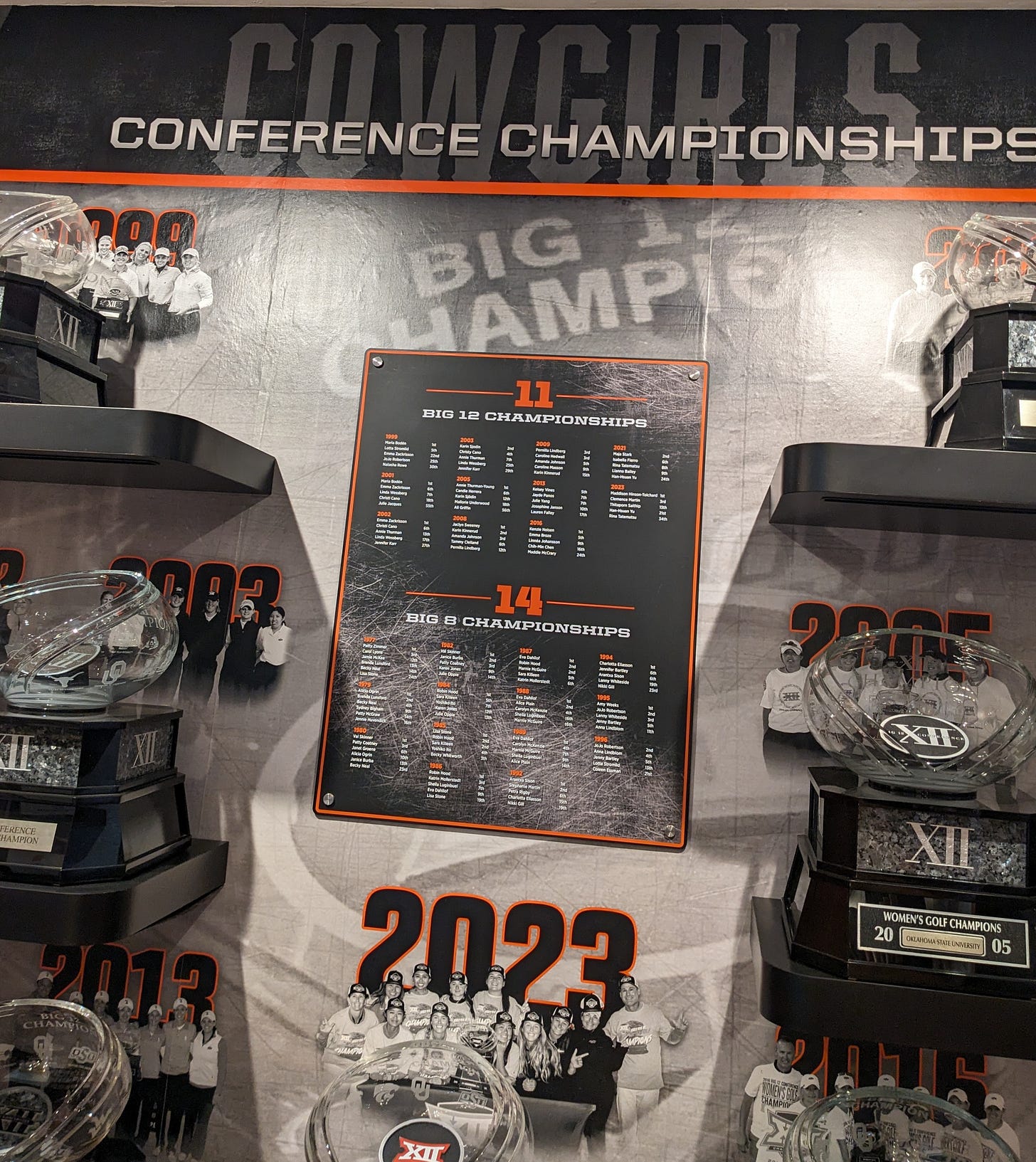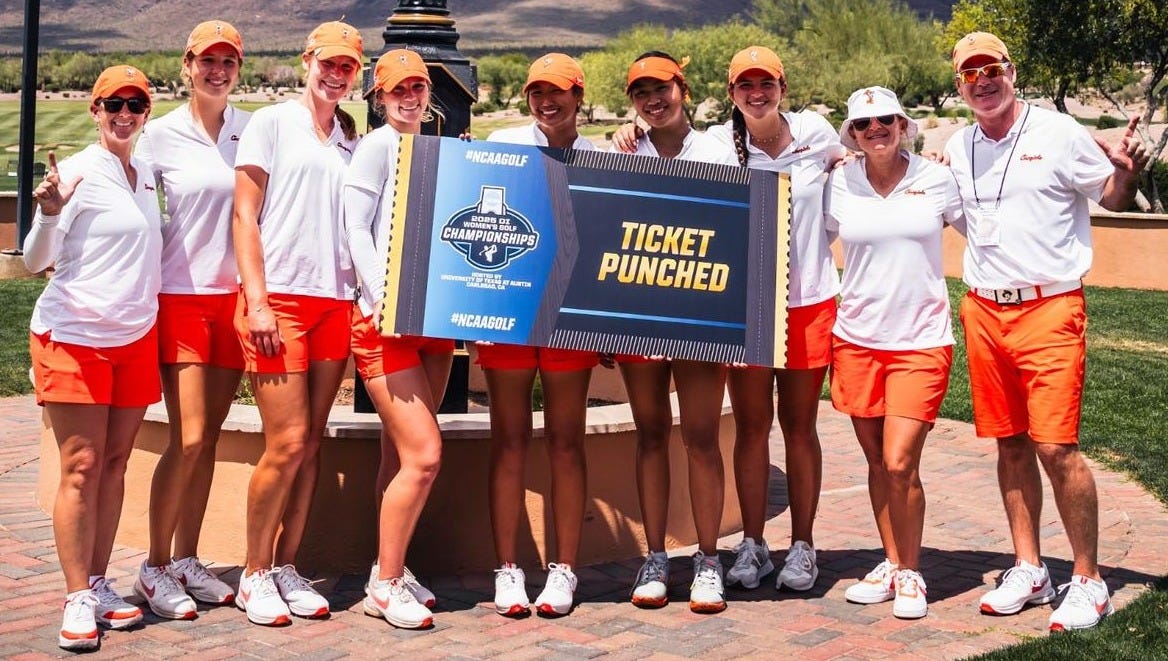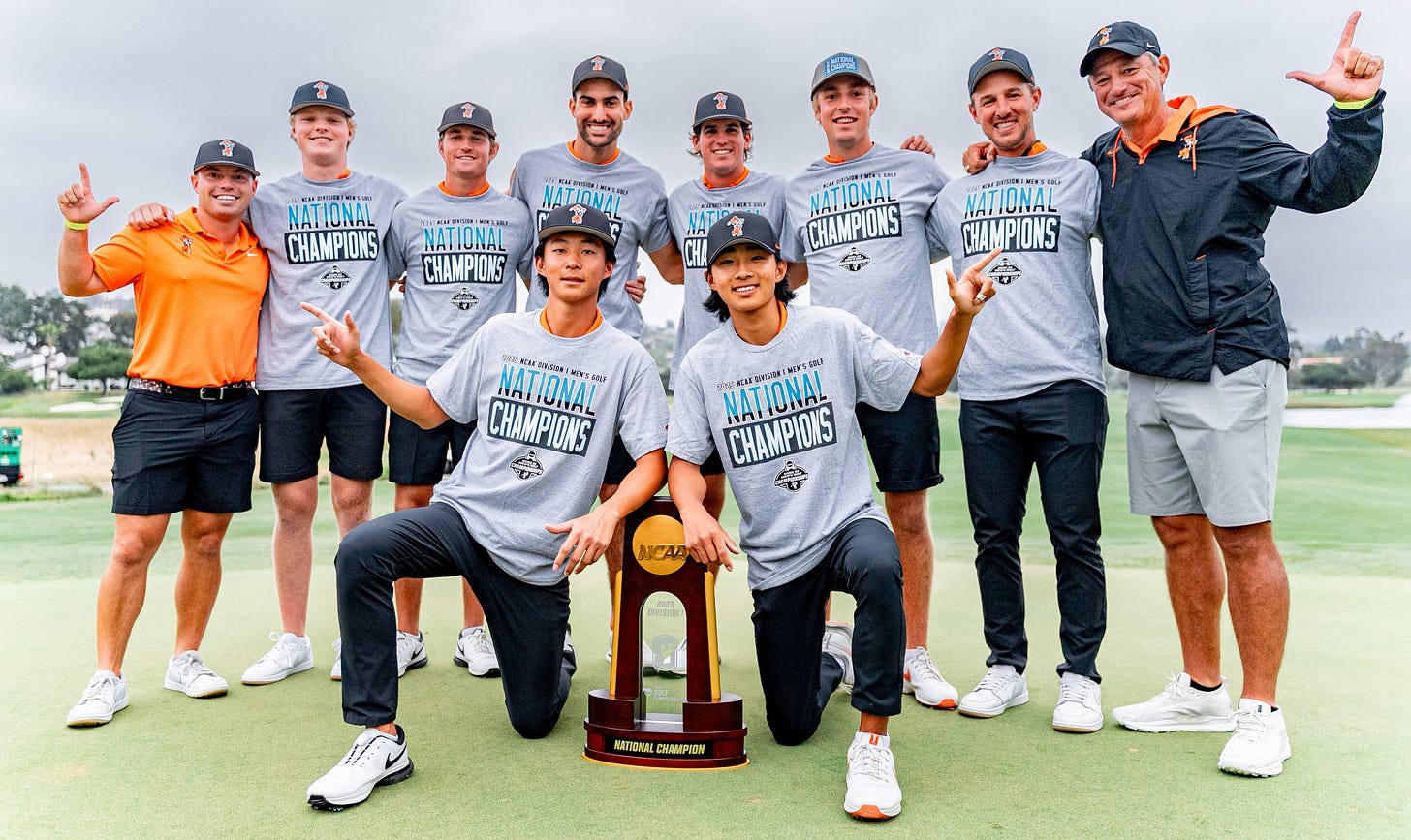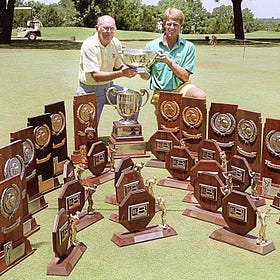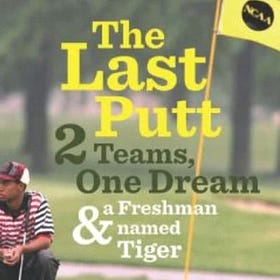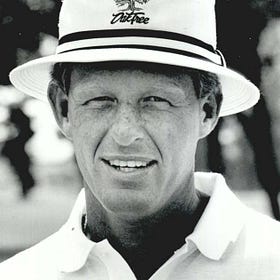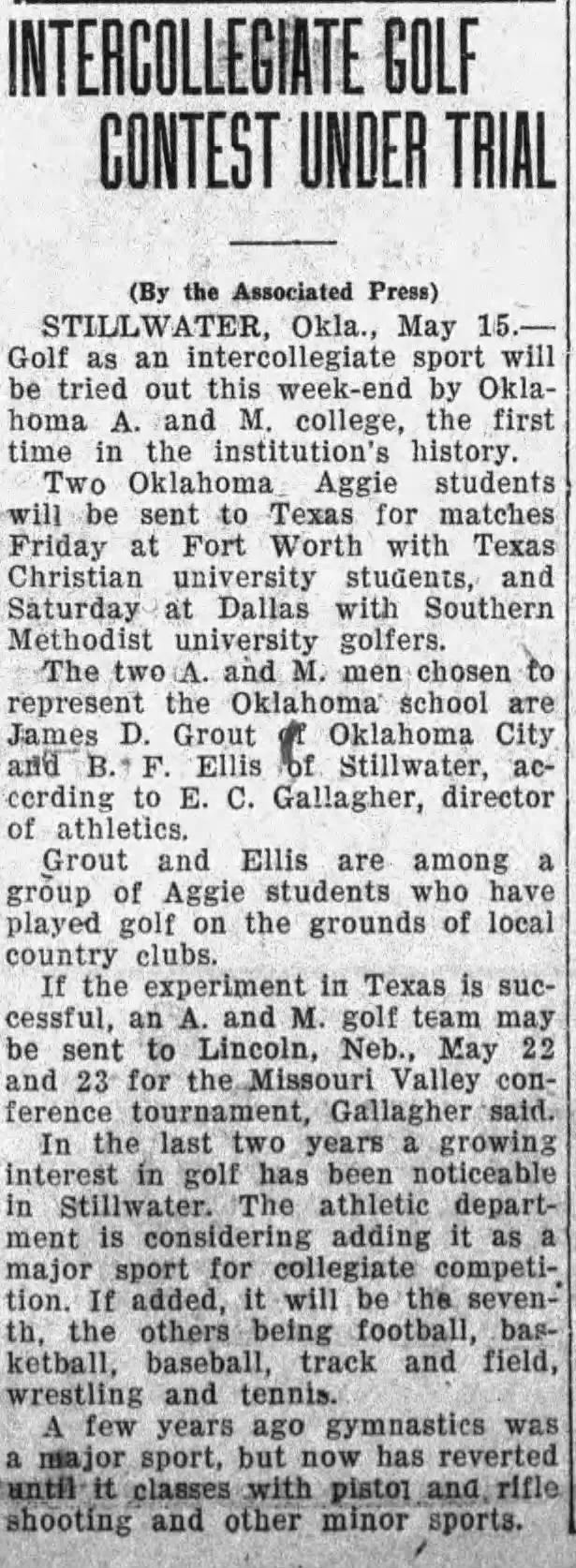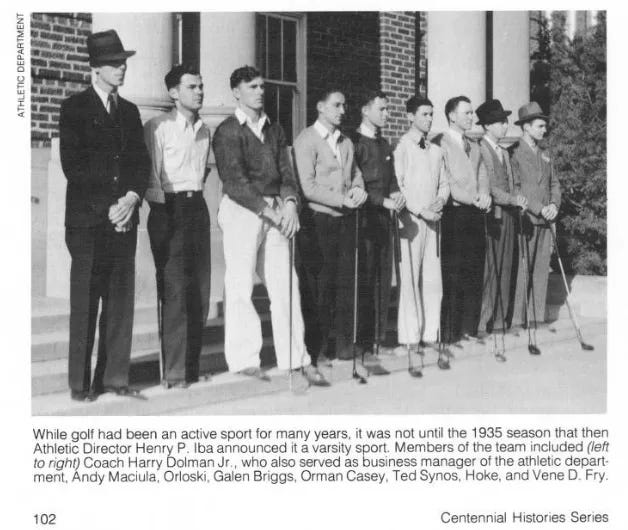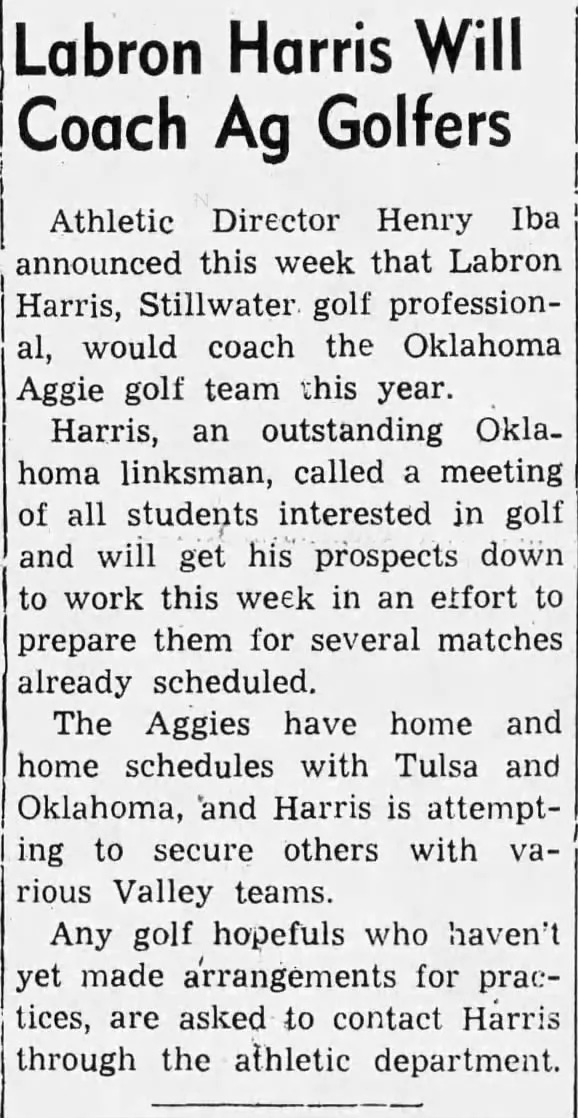For some, a dream destination involves a warm beach and a cold beverage. Others picture a place far from home with various rides, attractions, and things to buy. You don’t have to be golf-obsessed to dream of visiting one of the great courses around the world, however you venture into “sicko” territory when that dream involves going to a course that you never even play!
Nestled off an unassuming turn from Oklahoma Highway 51 less than 10 miles outside of campus, Karsten Creek is the home of Oklahoma State golf and arguably the greatest collection of college golf history imaginable. On an absolutely perfect day for golf, I spent a blissful afternoon touring the inside of my dream destination and had the best day possible. Sicko behavior? Absolutely...but let me show you just why this Clubhouse beats out the House of Mouse for any college golf fan.
You’ll notice my use of “Karsten (Creek)”, which is my attempt at bridging the gap between the past and future names of the course, something that will make more sense at the end of this post.
Bonus: here is a cool AI-generated podcast that covers a majority of the written info below. Note that I couldn’t get them to properly pronounce Coach Labron Harris’ name or “PING clubs”, but still makes for a nice way to get most of the same info from this (rather long) post.
*NOTE: underlined text provides a link to references or sites with more information
BEFORE [~1946]
Coach Labron Harris
It’s impossible to overstate the impact Oklahoma A&M (later Oklahoma State) had on the history of college golf, and it starts with Athletic Director Henry “Hank” Iba’s decision following WWII to not only hire one of the state’s top pros to coach a golf program, but also fund him early on with scholarships. Labron Harris is considered the “Father of OSU golf” after (re-1)starting the program from scratch in 1946. Coach Harris leveraged his remarkable playing and teaching abilities to elevate the players who joined his program, but more than that he spent the next three decades instilling an institutional mindset of toughness and excellence which carried on well past his retirement in 1973.

Lakeside Memorial Golf Course
Before diving into the history of Coach Mike Holder’s course, we should first give some context by examining the course he played on, designed by his own coach Labron Harris. From their website:
Designed by Oklahoma State Golf Coach Labron Harris in 1945, Lakeside Memorial is Stillwater’s most historic golf destination. Lakeside served as the home of the legendary Oklahoma State University Golf Team for almost 50 years. Rickie Fowler, Bob Tway, David Edwards, Doug Tewell, Scott Verplank, and many other PGA Tour players sharpened their games using the facilities at Lakeside.
In 1998, celebrated architect Tripp Davis renovated Lakeside to its current layout. The golf course wanders through giant oaks in the gentle rolling hills of north central Oklahoma. Featuring SR-1020 bent grass greens and zoysia/bermuda tee boxes, Lakeside offers the finest playing conditions in Stillwater. With these amenities, its no wonder that Lakeside is annually named on of Golf Digest Magazine’s “Best Places to Play”.
While Lakeside was (and is) a fine course, Coach Holder had a vision of something even bigger to challenge the best collegiate players and forge champions. Along with the base notion of creating/developing a course of his own, Coach Holder also seemed to be inspired by the way Coach Harris had used volunteer labor as a viable cost-saving method for bringing that course to life.
REALIZING A DREAM [1994]
It took about 20 years for Mike Holder’s dream to become a reality, but all of that effort and struggle is a significant part of what makes the end result so meaningful. The long winding drive approaching Karsten (Creek) from the highway is lined with affirmations such as “Obstacles = Opportunity” - a message that applies as much to the destination itself as to the challenges awaiting those touring the manicured course.
Mike Holder: From Player to Coach
You never know what might turn the course of history. Mike Holder told the story on Coach McGraw’s Better Than I Found It podcast (see below) of how seeing the All-American plaques and NCAA trophies adorning the walls at Lakeside Memorial played an integral part in his coming to Stillwater - and later putting the same emphasis on displaying achievements at Karsten Creek.
Following a successful collegiate career where he added several plaques and trophies to that showcase, Holder succeeded Harris as head coach of the Cowboy golf program in July, 1973. His eventual 32-year coaching career - to say nothing of the years he spent afterwards as the OSU AD - was one of the most dominant by any coach in the history of the sport.


Fundraising and Building the Course
Not long after becoming the head coach, Holder knew he wanted to build his own course and even found a plot of land near Highway 51 that was mostly owned by Oklahoma State University. He wanted to ensure that the course was built debt-free and without any strings attached, so he purchased the land from the University - at fair market value as Coach is quick to point out - and raised all of the funds to not only create the course but also establish an endowment for the future.
None of this came easy, however, and took about 20 years to actually happen. Shortly after Coach Holder’s team won their first championship title as a in 1976, the National Golf Foundation drafted a golf course feasibility study as the first step towards its creation. A few years later, Holder was put in contact with a young, relatively-unknown golf course architect named Tom Fazio who visited Stillwater and created an initial routing plan.
While Coach Holder’s teams continued to find success and win championships over the next decade+, in the background he slowly raised the funds he needed. By the time Holder had enough land and money secured to even begin clearing trees, Fazio had gone on to become one of the best and most sought-after architects in the world. Despite fears he would no longer be available due to time and/or cost, Holder was relieved to find Fazio remembered their original arrangement and agreed to take on the project beginning in the early 1990s.
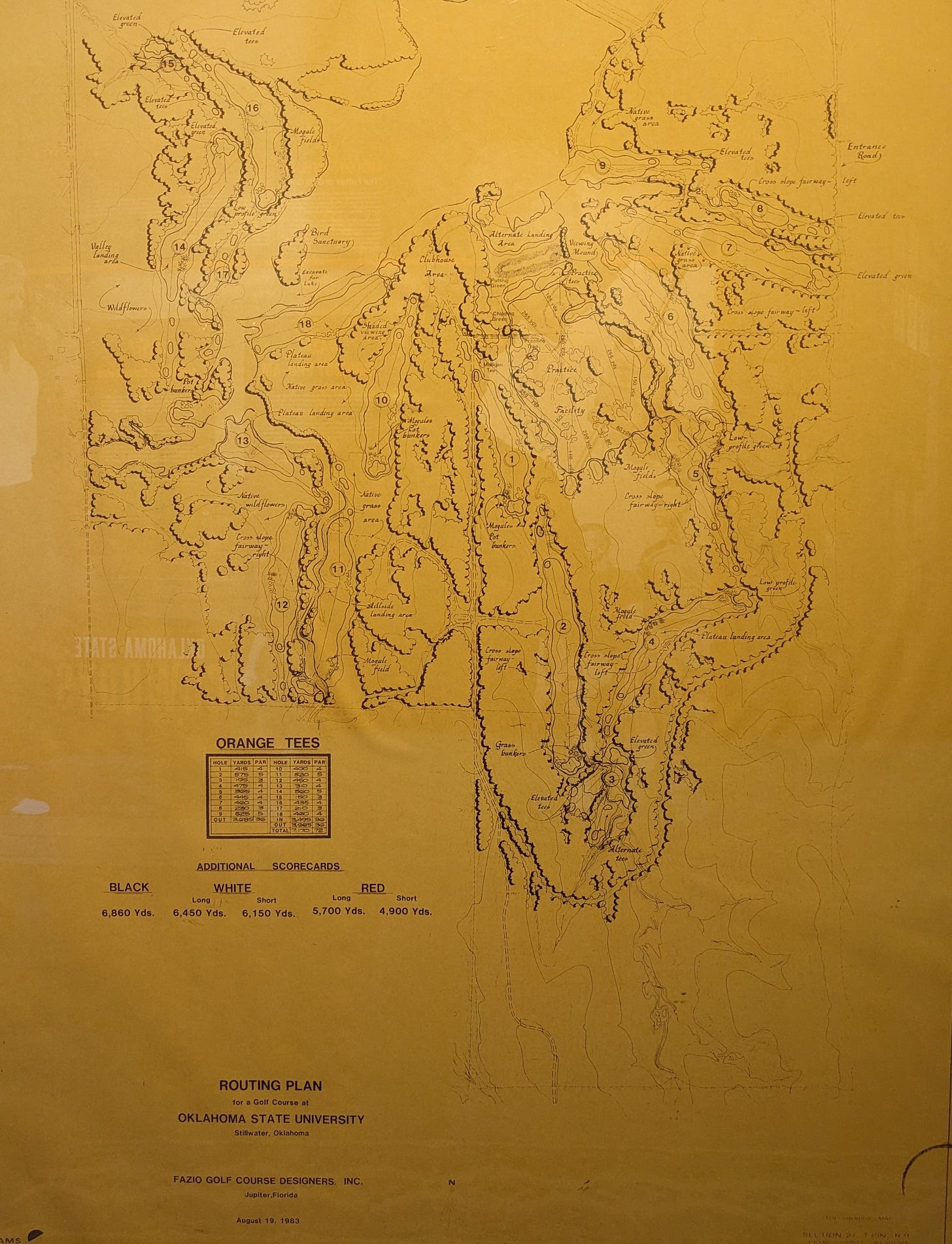
Donors such as Ed Joullian, Dr. Wiley McCollum, and (especially) T. Boon Pickens are vital to the story of Karsten (Creek). Not only did they make gifts in the form of land purchases, general monetary donations, and even sponsoring an individual hole on the new course (which Coach Holder and his wife Robbie also did with their own money), they also were ardent supporters of the program and its annual fundraising event. The Cowboy Pro-Am was started by Coach Harris as a way to raise the necessary funds to host the 1973 championship at Stillwater CC, and has continued annually to be a fundamental aspect of the OSU golf programs’ financial freedom. In fact, money raised through that event funded the construction of the clubhouse I toured (completed in 2003) to house all of the history, and was vital in funding the recent redesign. One of the first things that greets visitors to the clubhouse is a stately stone structure known as the Ring of Honor which is adorned with plaques paying homage to the donors and others who helped make the dream a reality.
At long last in May, 1994, the course was opened and ready for play. However, it wasn’t the golf teams who got to play first. Coach Holder ensured that each of the donors got to be the first to traverse the hole they funded. Only then were the collegiate players, including then-senior Alan Bratton and his 1994-95 NCAA champion Cowboy teammates, able to lay claim to their new home.
Karsten & Louise Solheim and Gary Hart
The Karsten Creek name comes from one of OSU golf’s biggest benefactors: Karsten Solheim, the founder of Karsten Manufacturing known primarily for the creation of PING golf equipment. The course’s namesake has an interesting connection with OSU golf and by extension college golf history. Gary Hart had been hired by Solheim in the early 1970s to make inroads in getting Ping clubs in the hands of PGA Tour players. Initially not finding much success, Hart made connections with Coach Holder who eventually got his future-pros playing the clubs, including 1978 individual NCAA champion David Edwards. Later, OSU’s use of a new type of “stand bag” with plastic legs that hinged out to form a tripod made them popular across collegiate golf before exploding on the mass market.
The Hart-Ping-OSU connection proved fruitful in many ways, and the Solheim family eventually contributed over $4 million towards the project that would bear the family’s patriarchal name. Lake Louise, named in honor of the matriarch, plays a prominent role on the design of the course’s back 9 and especially the finishing hole which has a plaque bearing the name of Mr. Hart.
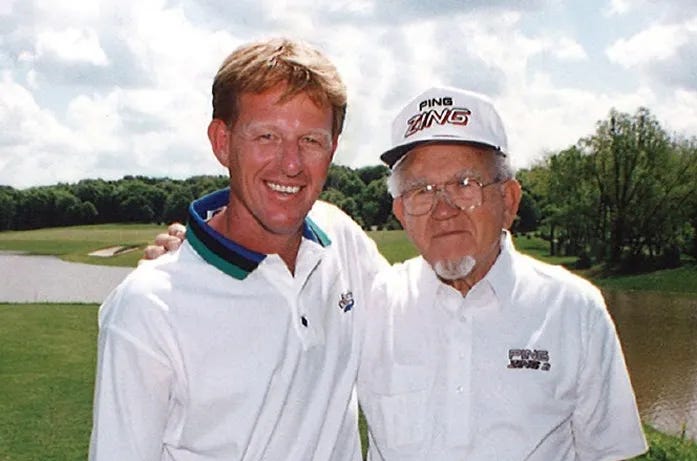
NCAA CHAMPIONSHIP HOST
Over the years, Karsten Creek has hosted several collegiate tournaments. The first was the Karsten Creek Collegiate in 1996. In 2001, it served as host to the men’s Central Regional. The outer portion of the Ring of Honor in front of the clubhouse is decorated with plaques detailing the results of the four NCAA championships the course has hosted, starting with the 2003 men’s championship.
2003 Men’s Championship
In his 30th season at the helm of the Cowboy golf program, Coach Holder realized the dream of hosting the NCAA championships at the course he built. His team had high hopes coming into the tournament not only because they were playing at home, but because of the incredible season that included five victories, the most for the program since 1996-97. The Ping/Golfweek Preview held back in October showed that scoring would likely be high as Augusta State won with a 54-hole team score of +16/888 - six strokes better than Clemson - while the Cowboys finished in 7th at +35/899.
Fast forward to June, and the the three Regional winners - Clemson (East),OSU (Central), and UCLA (West) - finished 1-2-3 at +39, +41, and +45 respectively. It was the most over par a winning team had shot since UCLA won in 1988 (+40) and has since only been eclipsed by UCLA in 2008 (+42). Clemson had been ranked #1 nearly all season and capped it off with its first national title. The 17th hole played a pivotal role in making or breaking teams’ rounds, playing almost a full shot over par at there were more bogeys (213) than pars (209) and even more triple bogeys (28) than birdies (20)!
Arizona State’s Alejandro Canizares shot a final round 69 to beat out 54-hole leader Lee Williams [Auburn] by two strokes, becoming just the sixth freshman in NCAA history to capture the title. Getting under par over four rounds (-1/287) was a testament to Canizares’s incredible play and in fact there are two interesting facts about that:
His final round 69/-3 was a little over 8 strokes better than the field average (Strokes Gained Total) and is the 3rd best final round SGT of a champion behind just James Lepp’s [Washington] 63/-7 in 2005 and Jamie Lovemark’s [USC] 64/-6 in 2007
His total of -1/287 stood as the closest to par for a winner since 2003 until 2022 when freshman Gordon Sargent [Vanderbilt] won a playoff against 3 other players who all finished even-par 288
2011 Men’s Championship
The scoring was lower in 2011 - the best score through 54 holes being +8/872 compared to +24/888 at the same point in 2003 - but the course still proved it could not be dominated. John Peterson [LSU] won by a single stroke over Patrick Cantlay [UCLA] with an incredible group of five players finishing T3: Peter Uihlein [OSU], Patrick Reed [Augusta St], Cameron Peck [Texas A&M], Lion Kim [Michigan], and JJ Spaun [San Diego St].
Although UCLA finished on top of the leaderboard through 54 holes of stroke play, they were not crowned the champs since there had been a change in 2009 to have the top 8 finishing teams qualify for a match play bracket. Oklahoma State finished T3 with Illinois. After winning the tie-breaker for the #3 seed, OSU dismantled Ohio State and set up a date with the defending champion Augusta State Jaguars who had beat the Cowboys in the Finals in 2010. Far from a Cinderella story this year, the Jags managed to close out the hometown Cowboys (again) and then the Georgia Bulldogs on their way to the first championship repeat since the 1984-85 Houston Cougars.
2018 Women’s & Men’s Championships
The 2018 NCAA championships at Karsten Creek are considered to be some of the best in recent memory. Fans were treated to two weeks of incredible play that concluded with dramatic finishes. Just three years into adopting the match play format, the women’s Final between Alabama and Arizona came down to the very end, showcasing the wonderful 18th hole. The men’s Final between Alabama and Oklahoma State was not as close, yet the hometown fans were near delirious with excitement as the Cowboys captured the program’s 11th national title. These few words vastly undersell the excitement of the tournament, so I’d highly suggest going back to read our post (link at the bottom of this post) that covers the men’s tournament in much greater detail.
THE ULTIMATE MUSEUM
While the outdoor offerings, especially the golf course, is the main draw, the clubhouse is home to the most robust museum in college golf. The long hallway connecting the player locker rooms and coaches’ offices is adorned with physical representations of the incredible - and incredibly long - program history. Trophies stretching back to the 1940s and 50s when Coach Harris led the Oklahoma A&M Aggies to multiple Missouri Valley Conference titles sit close by to Big XII and NCAA trophies earned ~75 years later under Coach Alan Bratton. The 5 second walk down the hallway can last 5 hours for someone consuming every detail of the trophies, awards, murals, photos, and All-American plaques that collectively tell a significant portion of the story of college golf history since WWII.
And this right here is where I spent a blissful afternoon, taking 20+GB of photos right up until my phone died. It’s not just that the old things were cool (they really were). These wonderfully preserved items are a collective physical representation of the last three-quarters of a century, college golf’s living record. The focus here is on OSU golf, of course, but Tiger’s name is on these walls. So too is Scottie Scheffler, Phil Mickelson, Fred Couples, Ben Crenshaw, Curtis Strange, Buddy Alexander, Jerry Pate, Tom Watson, Johnny Miller, Jack Nicklaus, and on and on all the way back to 1958 with legends such as Al Geiberger, Phil Rodgers, John Konsek, Tommy Aaron, and Jim Hiskey.
Despite the impracticality of doing so, anything short of listing everyone’s name here feels incredibly disrespectful; perhaps most of all to the 100+ All-American Cowboys from Donald “Ab” Justice to Eugenio Chacarra and all of the Earl Moellers, Mike Holders, Grier Joneses, David Edwards, Scott Verplanks, Brian Watts, EJ Pfisters, Alan Brattons, Charles Howells, Jonathan Moores, and Matthew Wolffs in-between! To see a comprehensive list of these players and all of their incredible accomplishments, please refer to the Oklahoma State Cowboy Golf Media Guide, which stands alone as one of the greatest compiled documents in the sport.

The Cowgirl program, which was founded in 1976 under Coach Ann Pitts, has its own illustrious history decorating those same walls. From finishing THIRD in the very first NCAA Women’s Championship in 1982 to winning multiple Big 8 and Big XII championships, the trophies and plaques earned by the women over the years rounds out the full story of the impact this program has had on the collegiate record books. In fact, their first Big 8 title came in 1977, just the second year it was offered by the conference and five years before the NCAA offered their first national championship.
Once again, I’m knowingly committing an injustice by not naming all of the women who earned their way onto these walls, from Robin Hood to Maddison Hinson-Tolchard and including one (multi-time earner and future coach) Annie Thurman-Young. Here too I will refer you to the Oklahoma State Cowgirl Golf Media Guide for further info.
2025 Post-Season Additions
The 2024-25 Cowgirls were so close to adding another Big XII trophy to the display case, falling just short in the first ever conference championship determined by a three team sudden-death playoff. Less than a month later, they finished third in the Gold Canyon Regional, punching their ticket to the NCAAs for the fifth straight season. Grace Kilcrease added her name to the illustrious wall of All-Americans with her WGCA Honorable Mention.
The 2024-25 Cowboys, led by GCAA First Team All-Americans Ethan Fang and Preston Stout who will add their names to that amazing wall of plaques, added some serious hardware to the cases. Alan Bratton - named Coach of the Year by the GCAA - led his team of underclassmen to their 12th Big XII championship, their 17th Regional co-victory, and then their 12th NCAA title. On the 30 year anniversary of his 1995 championship, former-Cowboy-senior-now-coach Bratton shared the infamous story with his players of the notes his teammates received insisting they “believe in destiny” before ultimately defeating Stanford (led by freshman phenom Tiger Woods) in the first ever NCAA playoff. Fang took this message to heart, inscribing “B.I.D” on his golf balls prior to their 2025 Finals victory.
Those displays will undoubtedly look incredible when updated with these latest treasures!


REDESIGN [2023-25]
Redesigned by Andrew Green over the course of 18+ months from 2023-25, the home of Oklahoma State golf is the ultimate test for the members, collegiate players, and program alumni. The $31 million renovation brought in many unique aspects from the locally-developed turf to the miles of underground tubing for sub-surface hydronics that help control the year-round condition of the green complexes to a degree that would envy practically every other course in the world.
As you would expect, the grounds crew, led by superintendent Kyle Callahan, is as first-class as the sanctuary they tend. One of the things they emphasized is that their playground is less of an 18-hole course than it is a collection of 18 unique tests that will strain the sanity of anyone playing. Above all else, this is a battle of wills between you and the land, and here par is but a limiting construct.
If you’d like to get a visual walkthrough you can check out each hole **before the redesign** archived by The Golf Course Gurus HERE, view the aerial view from the Karsten Creek website (first video below), or check out the Golf.com video below:
Rebranding to Karsten
The ground renovation also brought about a name change to just Karsten - no “Creek”, “Golf Course”, or anything else on the back end. Fans with long memories will recall that there was a Karsten GC in Tempe, AZ - also named to honor the contributions of the Solheim family - which was built in 1989 and closed in 2019. The course formerly known as Karsten Creek now stands alone in carrying on the name legacy of the family that helped build college golf in the background with sorely needed funds. Though Karsten may never host another collegiate event, it will continue to mold some of the best players in the sport, and in doing so, will undoubtedly add more stories to this house of history.
Thanks for reading! Leave a comment below or send me a message, I’d love to hear from you!
Feel free to peruse some of our previous posts on Oklahoma State victories and Coach Holder’s incredible coaching tree:
Oklahoma A&M/State golf goes back much further than Coach Labron Harris, but it is widely recognized by the University that the program as we currently know it was essentially (re)built from scratch by Coach Harris following WWII. In the interest of not contradicting this info, we used that as the basis for this assertion HOWEVER it should be noted that Oklahoma State put together this wonderful centennial book on their athletics which puts the start of their intercollegiate golf program at 1924 under the guidance of Tom Aycock and first awarded letters in 1936 under coach Harry Dolman. In fact, the Missouri Valley Conference record book reveals that Oklahoma State competed in their championship from 1936-1941. Golf was among the sports - tennis and swimming - that were dropped by the conference with the start of war, and was likewise dropped by OSU in early January, 1942. Coach Harris was hired to be the (men’s) golf coach in mid 1946, reviving it as an official varsity sport and jumpstarting one of the most historically significant collegiate golf programs in the country.







